- We associate step wells with Gujarat and Rajasthan. Thanks to the Maharashtra Stepwell Campaign by Rohan Kale & Team now know the state has atleast 1,750 step wells across regions. They can address water shortage and are part of our national heritage.
Excuse me, is there any Ancient Well nearby..? Well with steps. Ammmm….not actually well but there is an old tank that might have some broken steps… there it is under that big Mango tree...this way goes straight to the tree…wait come with me. Road is not clear and goes through the forest. You cannot find it easily…
Wow Awesome. Too Big. Oh four Entrances and Niche also Amazing… Why don’t you use it? It has enough water in the summer season also… you should use it … otherwise it will be history. This is not just a Tank…It is our Heritage. It is our duty to preserve it.
There are more than 1500 stepwells in
Maharashtra. If we revive and Preserve each Step
Well then the Problem of Water Shortage in Maharashtra will be solved
permanently. If we start it now then only our Rich Heritage will remain
for further generations.
The conversation is between Rohan Kale, Manoj Sinkar and an ordinary villager in Maharashtra. They searched for several abandoned Step Wells and mapped them publicly on Google Map. Rohan Kale quit his Corporate Job for his passion to Revive Stepwells. For six months he rode all over Maharashtra clocking almost 14000 Km. He searched and visited 400 stepwells and recorded/noted their exact GPS locations on Google Map. Importantly, he convinced many people about the need for conservation of Stepwells and involved many more in this conservation project.
This is how the “Maharashtra Stepwell Campaign” started. Rohan always says, “This is not my personal Campaign, the campaign belongs to the people of Maharashtra.”
To date more than 1,750 stepwells are mapped under this campaign. The campaign started with several objectives.
1. Creating the largest and most reliable
database of Stepwells in Maharashtra for research and conservation purposes.
2. Identify thousands of Stepwells
(capturing gps coordinates and mapping them on custom google map for public
view).
3. Capturing Photographs/ Drone Shots of
Stepwells.
4. Collaborating with colleges for study
of architectural designs of stepwells.
5. Organizing cleanliness drives.
6. Collaborating with people and
government for conservation of stepwells.
7. Encouraging villagers / local heritage
explorers to identify unique stepwells as tourist attractions.
8. Organizing free study tours for
students.
9. Sharing good work done by respective
village locals/authorities in conserving stepwells through social and print
media to motivate other villages/states.
10. Developing ecological water
purification system for stepwells.
11. Solving
the water shortage problem of Maharashtra and Heritage Conservation are the
Primary Visions of Maharashtra Stepwell Campaign.
Revival, preservation of these stepwells is everybody’s duty and not only of the volunteers working for this campaign. Volunteers are working hard for this. It is due to their efforts that Maharashtra Tourism Development Corporation (MTDC) has created a separate page for Stepwells on their website,
many stepwells in different districts have been revived and youth are coming
forward and showing interest in this work. Social and print media are helping
to increase the reach of this campaign. They regularly publish how people and
administration help revive a random stepwell.
Last Mahashivratri, Maharashtra Barav Dipotsav arranged for almost 160
stepwells, across Maharashtra, to be decorated with lamps. This Dipotsav will
continue forever. On the birth anniversary of Rani Ahilyadevi Holkar people
from village Shirpur, Dhule decorated a five storey stepwell with lights. They
also organized a lecture and cultural programs.
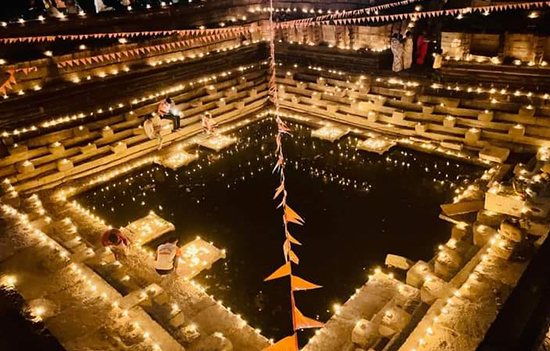 Maharashtra Barav Dipotsav.
Maharashtra Barav Dipotsav.
A stepwell is not only a source of water. It has a different sort of architecture. Some stepwells are small enough to fit in a bedroom whilst others can accomodate a whole building inside. Plenty of designs…. Some stepwells are rough, some are finished. We can find 125 years to 1200 years stepwell in Maharashtra. It is like a separate branch of study for both architecture and civil engineering also for the history students as well as for the historians. Tourist guides or Tour arrangers can expand their business as Stepwell Tourism. This will help local people and heritage explorers. This would give a fillip to tourism and generate employment.
Oh, but what
does Stepwell exactly mean? Sorry I forgot to explain. I must explain
what a stepwell is? How to identify it? How many are its types?
Stepwell means a well or a water tank
which has stairs to reach the water. We can find proof of wells in the Indus
Valley Civilization. In the days before the invention of electric or diesel
water pump, people used Rahat (a hand
operated wooden winch to pull water bucket), Paay Rahat (a foot operated wooden winch to pull water bucket), Bail Rahat (a bullock driven wheel winch
to pull a chain of water buckets). Step wells were useful to travelers,
villagers, traders and for agriculture. That might be a major cause for the
birth of stepwells. One can directly reach the water with less energy.
Step Wells were built by many ruling
dynasties. The monarchs from Satavahanas to Chalukyas, Chhatrapati Shivaji
Maharaj, Chhatrapati Shahu Maharaj, the Peshwas, Rani Ahilyadevi Holkar and
many philanthropic rich people built these stepwells. Some stepwells have the
Inscriptions engraved on it so we can know their age and history.
In Marathi there are different names for
every style like Barav, Kund, Pushkarini, Pokhran, Ghodebav, Pandav Kalin / Shivkalin Vihir, Katlkhod vihir
etc. In English they are known as Step wells and Step Tanks.
How to identify a step well? Every region has a different style of architecture. Let’s have a look through every region.
I would like to start from my native
region of Konkan. In Konkan you can
find three types of designs. Ghodebav
means a well carved down into a laterite rocky land surface with one side
staircase entrance. They are found throughout the region. Second type is a Kund (step tank) which is found near old
temples. And third, Pokhran or Pushkarani is a central water reservoir created
for public water supply.
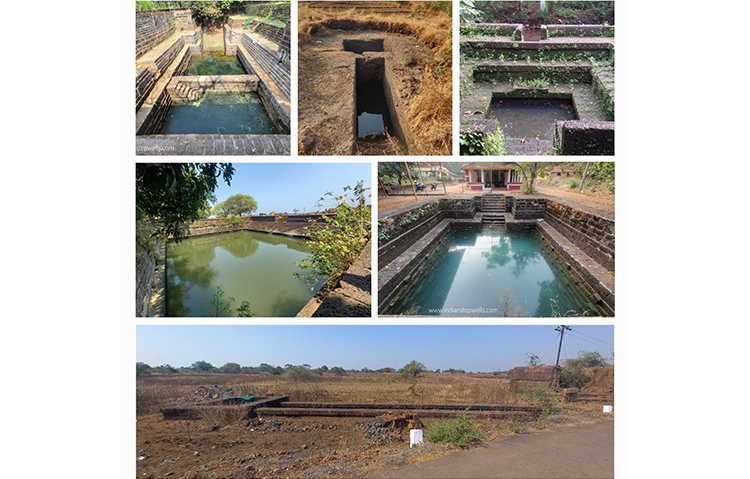 Step-wells in Konkan region.
Step-wells in Konkan region.
From the top left. First stepwell is near
Ganpatipule Temple. It has three entrances. Presently only the main big
entrance is in use. This step tank is regularly kept clean by the temple
authority. The temple is almost 500 years old so the step tank might be of the
same age. In Konkan there are 120 to 500 years old temples in many villages and
almost every temple has its own well or step tank.
Main purpose of these tanks is to provide
water for religious rituals and worship. There are many Kunds in Ratnagiri,
Raigad, Thane and Sindhudurg districts; most of which belong to the temples and
hence they are still alive and protected or brought in use.
The second one in the picture is dug into
the plain laterite surface. Local name for this type is Ghodebav means a horse can descend to the water. Some of these
wells are rough and some are finished, some of these are protected by walls
built of big laterite stones. These stepwells are just along the road. (see
image below) In earlier times, before the invention of vehicles, people used
waterways, walked or sailed. And trade routes connected harbours and dwellings.
Journeys were lengthy, most people would walk, a few travelled in carts.
Therefore stepwells were built along the way which would provide relief to
thirsty men and animals.
It is very clear that those ways were used as major roads. 'Cattle walks develop into human paths and grew to be highways.' These apparently simple things can throw light on an aspect of human evolution.
Wells seen in the third and fourth (right
side of middle row) images are also small kunds. The Kund in the third picture
might be the youngest stepwell (125-130 years old). Image to the left in the
middle row is the rare type found in Konkan. It is a specially built central
water reservoir and used for farming.
The style to build stepwells also changes
with the geographical conditions. One can find every type of stepwell in every
district of Maharashtra but the size, material used and storage capacity
differ.
In Ratnagiri you find mostly Ghodebav dug
into rocky plains. In Sindhudurg there are more Kunds. In Thane there are both
types but material used is different. Stepwell in the first picture is located
at Badlapur, has walls built to the bottom. The other pic below is near
Sapteshwar temple, Sangameshwar and symbolizes the glory of the region in the
old times.
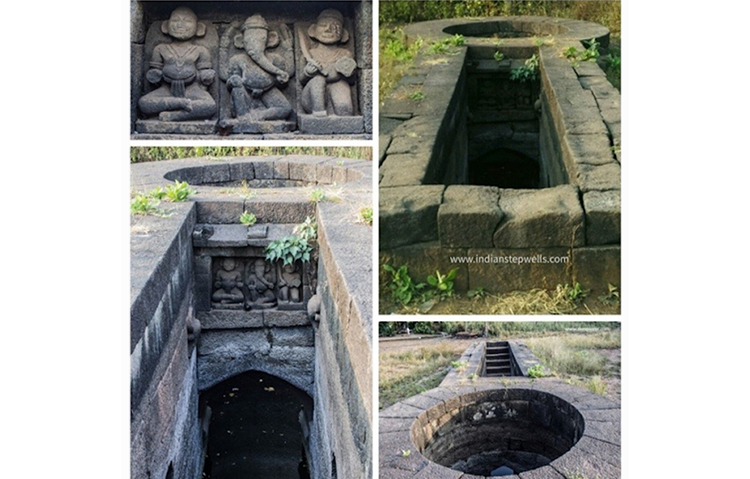 Badlapur Stepwell.
Badlapur Stepwell.
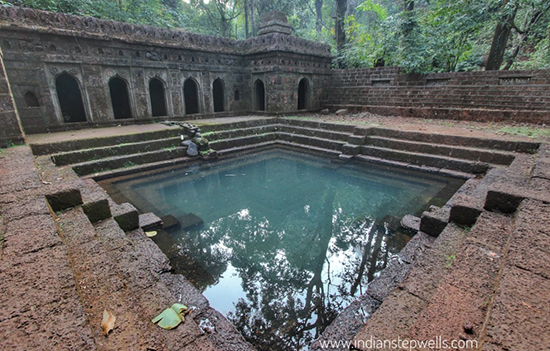 Sapteshwar Stepwell.
Sapteshwar Stepwell.
Now let’s move to Western Maharashtra. It covers modern day districts of Ahmednagar,
Pune, Sangli, Satara and Kolhapur. These districts have a long history, being
the centers of power of many dynasties. So you can find here every type i.e. L
, Z , U , T shaped stepwells, Pokhran, Pushkarini, Kund which are more
attractive to see and having more finished structures.
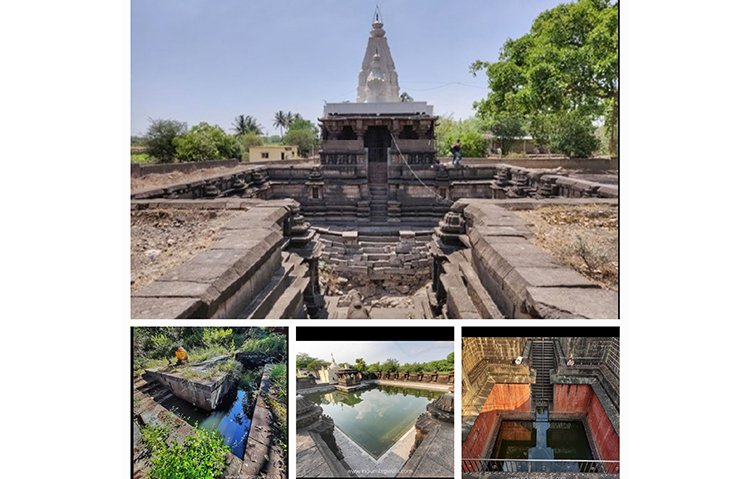 Stepwells in Western Maharashtra
Stepwells in Western Maharashtra
Take a look at the top and far right
stepwell in the below line. A man standing at its edge signifies the hugeness
of the stepwell. Everywhere in Maharashtra except Konkan steps of the wells
seem to have been descended very deep (except Ghodebav.)
Far right in the below line- this
stepwell belongs to the Jejuri area, beside Ballaleshewar temple. See how
attractive and finished it is. In spite of the major objective of water supply,
magnificence and fineness are a characteristic of wells in this area. The
size of these wells is likely to be large enough to meet the water needs of
many people, the army, the old ancient pilgrimage site and the devotees
visiting the places.
In the
middle photo in the lower row is the most beautiful type of stepwell - Pushkarini. Just sit on its banks for
hours and observe the beauty. A pushkarini mostly has Niches on its side walls.
Sometimes there are some beautiful murtis of Gods-Goddess or the niche is left
empty for the Brahman (the priest) for performing rites. You can see beautiful
artifacts on the Pushkarini. On the stepwell of Manchar there is an Inscription
engraved which tells us that it was constructed in the 14th century. As these districts were the power
centers of many dynasties for a long time, many artists stayed there, so you
can find stepwells of different shapes like L, Z, U, T. Picture in the far left
block shows an L shaped stepwell.
There is a beautiful Z shaped stepwell in Kolhapur city, unfortunately I don't have its photo. As well as stepwells with 2 or 3 or more entrances are commonly seen here. Stepwell near Limb Bara Motechi Vihir is a beautiful example of architecture. You can step into the water, can also see 12 Mot (roped bucket pulled by bullocks) to pull out water and if you just need a calm place, get down in the well. Wonderfully, there is a tiny mansion built in with natural air conditioning. This was constructed in 1719-1724 (source wikipedia) to supply water to some nearby 300 mango plantations. As am a resident of a mango city I know that 300 mango trees never need such a big well. A symbol of royal wealth, it was built by Virubai Bhosale (secondary wife of Chhatrapati. Shahu Maharaj)
One of the reasons behind such big,
magnificent wells is who built it and how much money could he/she spend?
Stepwells
in Marathwada: This covers districts of Aurangabad,
Jalna, Parbhani, Hingoli, Nanded, Beed, Latur and Osmanabad. There are number
of step wells here. Stepwells of Shiva linga or Horse well shape are a few in
this region. Wells with artistically constructed steps on all sides, convenient
to walk into are seen in large numbers.
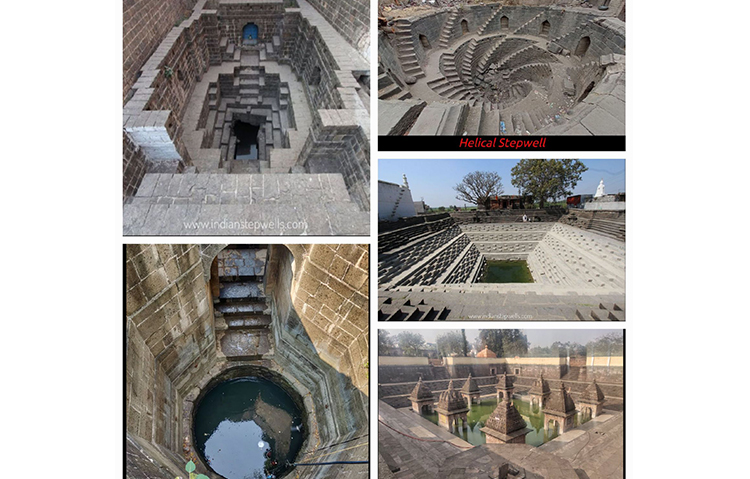 Stepwells in Marathwada
Stepwells in Marathwada
Irrespective of the actual depth the actual
pond is very small, while the surrounding work occupies more space and looks
very finished. Stones of different colours are used for their construction. The
large size ofcould be attributed to the influence of the neighboring states of Karnataka
and Telangana.
Water scarcity in the Marathwada region
might be the reason for such huge steps well, all for public benefit. They are
generally built with repeated sets of four or five steps followed by spacious
platforms. Gates vary in numbers and style. Pictures in the article ably depict
the variety of the structures.
Stepwell seen in top left photo displays
several kinds of steps. One with circular stairs in the picture beside it is
the only of its kind in Maharashtra. Located at Valur, dist. Parbhani it had
been laying buried under ground for several years. Local people excavated it
thus a beautiful structure was revealed. The step well in the lowest right
photo has eight little shrines at its bottom. This is teerth, the well with space left for the priests and hermits to
perform rituals like yagya. Water in such wells is believed to be pious.
The whole of the Marathwada region has
expressed wide public participation in the campaign. Youth in the region cleaned
and resurrected several stepwells which were simply used as dumping spots for
years. They are important symbols of our heritage. We also noticed the influence
of different architecture and culture.
Step
wells Vidharbha: Let us now move
to the phenomenal world of multi storied stepwells. They are so beautiful that
one can mistake them for well-turned buildings.
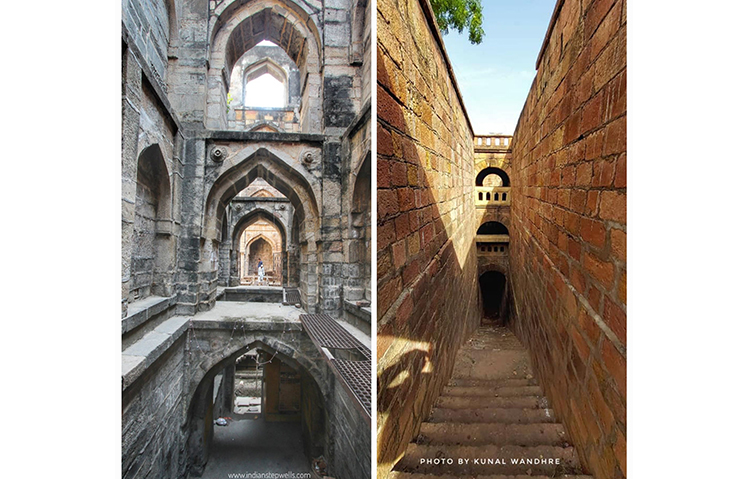 Stepwells in Vidharbha
Stepwells in Vidharbha
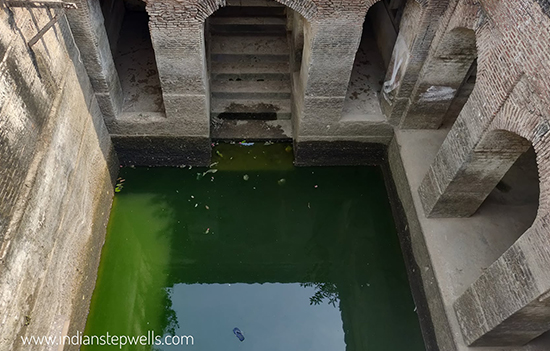 Stepwells in Vidharbha.
Stepwells in Vidharbha.
Stepwell Tourism has huge potential. Almost
every type of stepwell is found in Maharashtra, with proportionately larger
shape. The horse wells, usually a Konkan form is seen here as a three storied structure.
If in earlier times there was a guard he must have asked passersby to drink
water and have rest on the upper floor.
These huge stepwells are built of bricks, sometimes of red or black stones. Pictures of lotus are carved on arch, entrances (are on three sides) and two storied niches. We can trace their period, year of carving and the creator's name, sometimes found in a verse.
Stepwells in the Marathwada and Vidarbha
regions go back to the times of the Chalukyas or the reign of Ahilyadevi Holkar
in the 18th century. Stepwells of this time are found in the
Khandesh region too. See pictures below of the huge step well. They are from
Vidarbha (i.e. modern day districts of Buldana, Vashi, Akola, Amarawati
Yavatmal, Varsha, Nagpur, Bhandara, Gondiya, Gadchiroli, Chandrapur etc.)
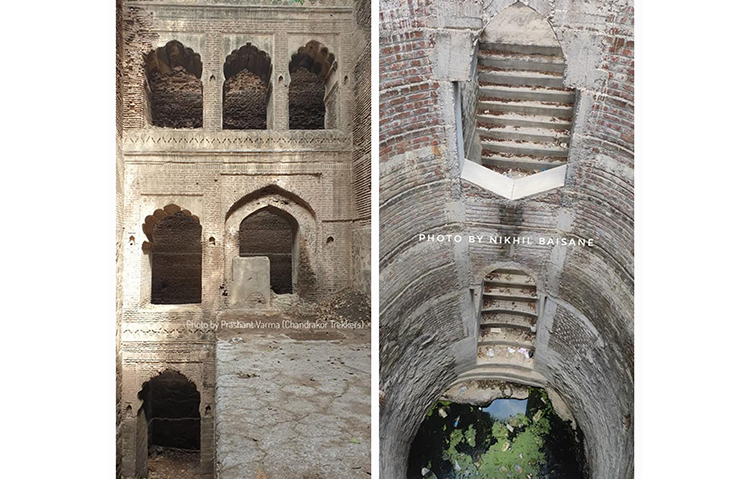 Stepwells in Khandesh
Stepwells in Khandesh
The condition of stepwells in the region could be much better. However, thanks to our campaign their cleaning and restoration has picked up. After facing years of water scarcity locals are realizing the importance and benefit of step wells. The youth are more involved in this campaign today. In a way it symbolizes the campaign’s success.
Besides Vidarbha, Khandesh (districts of Nashik, Dhule, Jalgaon, Nandurbar) too have multi storied stepwells. A five storied stepwell was discovered in the district of Dhule (in Khandesh pic above, it is stepwell on left of pic). It is probably the highest known multi storied stepwell in Maharashtra. On the occasion of Ahilyadevi Holkar's birth anniversary last May, it was decorated with peerless lighting. A palanquin procession and a lecture was organized.
Suggestions: Participating in this campaign does not require one to leave one’s job. What is required is to clean and conserve the wells in our villages and towns. We must, during restoration, avoid destruction of the original structure and unwanted beautification. It is better to consult with the archeological department or one who knows the method of ancient structures. Attempts for implementing projects under schemes such as Shivkalin water supply and Well
Conservation with the help of administrative agencies is recommended.
Promoting stepwell tourism with 'zero waste' may be a goal. This will spread the idea of the Stepwell Conservation Campaign, and might be one way to solve the problem of water scarcity in the state.
Author Shreerang is a key part of the Maharashtra Stepwell campaign. eSamskriti is grateful to him for writing this article and sharing pictures. We wish to thank Shri Rohan Kale as well. To know more about Maharashtra stepwells visit their site
See albums of step wells across India
1. Chand
Baori Jaipur
2. Hampi
Water system, Karnataka
3. Baoris
Bundi, Rajasthan
4. Rani-ka-vav
Patan, Gujarat
5. Adalaj-vav
Amdavad, Gujarat
6. Kannur,
Kerala
7. Panna
Meena-ka-kund Jaipur
8. Step-well Penukonda Fort,
Andhra Pradesh
9. Water tank or Kalyani at
Melukote, Karnataka
Adopt modern technology to solve water scarcity
problem by all means. At the same time, be open and willing to learn from our
ancestors. There is a lot we can learn as Team Rohan Kale have shown.
Also read
1. Why
temples/tanks have stepwells
2. Rise
and Fall of Traditional Forms of Water Harvesting in India
3. Water
from stepwell in Orchha used for irrigation
4. Eris,
a system of cascading tanks
5. How
ancient India preserved the heritage of water resources – Good read.
6. India’s profound kinship with water
7. TED talk by Anupam Mishra – the ingenuity of water harvesting 18 minutes VG.
8. Naul and Dhar – A Cultural Heritage of the Himalayas
9. Traditional
Forms of Water Harvesting and applicability
Some pics of famous step wells / water tanks /
kunds. These are invariably found close to temples.
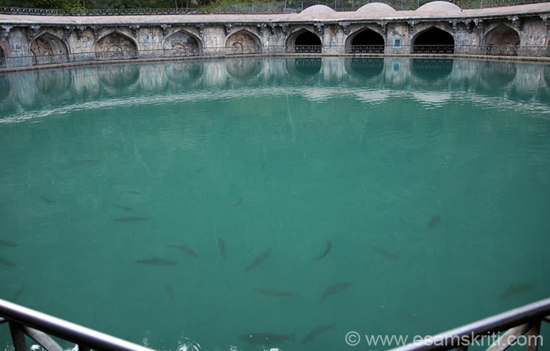 Kund Verinag, J&K is the source of the river Jhelum.
Kund Verinag, J&K is the source of the river Jhelum.
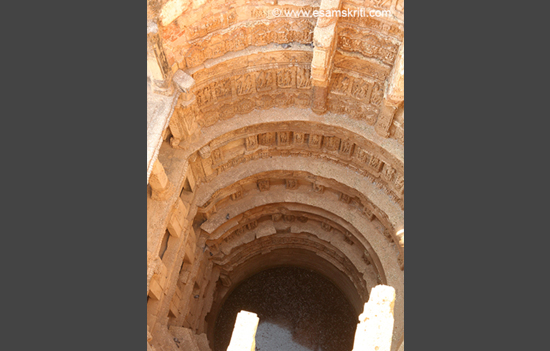 Rani-ki-vav, Patan, Gujarat
Rani-ki-vav, Patan, Gujarat
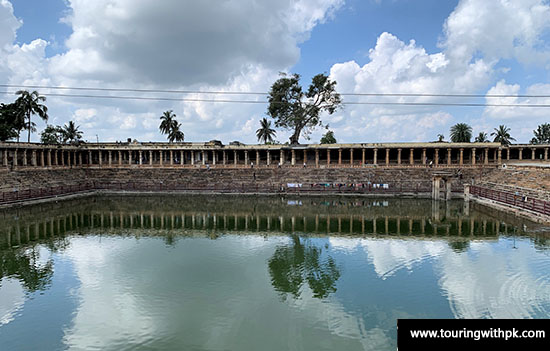 Melukote, Karnataka.
Melukote, Karnataka.
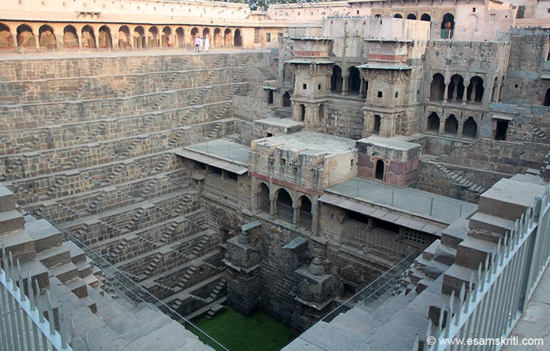 Chand Baori near Jaipur.
Chand Baori near Jaipur.
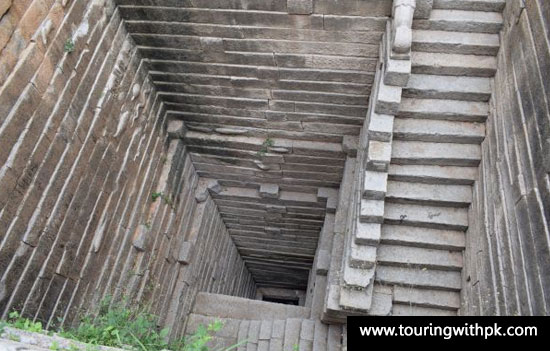 Penukonda Fort, Andhra Pradesh.
Penukonda Fort, Andhra Pradesh.
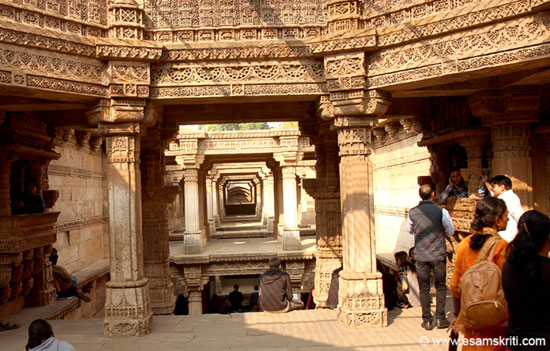 Adalaj-vav near Amdavad, Gujarat
Adalaj-vav near Amdavad, Gujarat